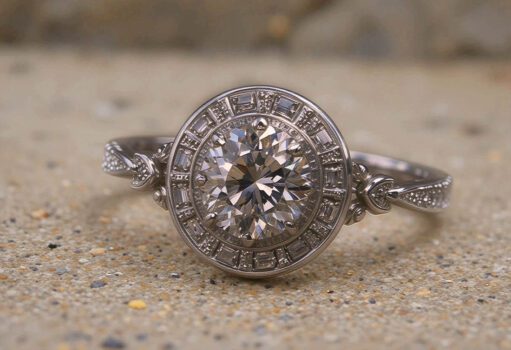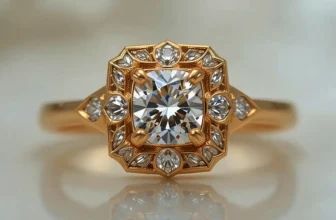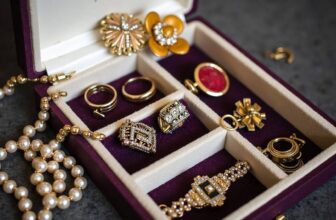Why Gemstones Matter in Art Deco Engagement Rings
Shopping Ads: Invest in Hidden Masterpiece: Rare Antique Oil Paintings For Sale. Limited Originals Available 💰😊 Are you looking for authentic hidden masterpiece? Explore old master antique oil paintings from the Renaissance and Baroque eras. From 16th-century portraits to 18th-century landscapes. Authenticity guaranteed, Old Master antique oil paintings for sale. Shop Now! 🎨 Renaissance And Baroque Art Old Master Portrait Paintings Landscape Antique PaintingsThe Art Deco era (roughly the 1920s through the 1930s) was more than a fashion movement , it was a cultural and aesthetic revolution. In jewelry, that translated into bold geometry, symmetry, architectural lines, and an emphasis on the contrast of color and light. In engagement rings of that period, or in later designs inspired by Art Deco, the choice of gemstone was integral, not incidental. The gemstone(s) would often be as much a part of the architectural design as the metalwork, filigree, and setting.
When one asks “Which gemstones were used in Art Deco engagement rings?”, the answer is not simply “diamonds, sapphires, rubies,” but rather a nuanced list of gems (both precious and semi-precious) that suited the era’s design ethos. Below, you’ll find a detailed breakdown of the common, occasional, and accent gemstones used, how they were cut or set, and how their properties aligned with the Art Deco style.
The dominant gemstone: Diamonds
The primacy of diamonds in Art Deco rings
In the realm of engagement rings, then and now, diamonds hold a privileged position. During the Art Deco period, diamonds were often the principal stone, especially in engagement settings. The reasons are multiple:
Brilliance and contrast: Diamonds’ high dispersion (fire) offered the kind of sparkle that complemented the crisp, sharp lines of Deco settings. They could reflect light across straight edges, baguettes, and geometric pavé work.
New cuts to suit geometry: The period saw the rise of emerald cuts, asscher cuts, baguette cuts, and step cuts in diamonds. These cuts were ideal for rectangular, symmetrical, tiered designs and offered a more restrained, architectural sparkle than round brilliants.
Metal choice and contrast: Many Art Deco rings used platinum or white metals (sometimes white gold) as their profiles, emphasizing cool metallic tones. The clear brilliance of a diamond was a natural match.
Durability: Diamonds are extremely hard and durable, which made them well suited to daily wear in rings with elaborate settings.
So while colored gemstones played a supporting role, the diamond was often the star or at least the anchor in many Art Deco engagement ring designs.
Diamond cuts in the Art Deco era
Understanding which gemstones were used also implies how they were cut. Diamond cuts common in Art Deco engagement rings include:
Emerald cut: Rectangular with step facets; the clean, linear geometry made it very compatible with the Deco aesthetic.
Asscher cut: A more square version of the step cut, introduced in 1902, became popular in the 1920s and 1930s.
Baguette cut (straight, narrow rectangular bars): often used as side stones or accents.
Step cuts: Emphasizing parallel facets rather than sparkle, step cuts allowed controlled light play aligned with straight-edge design.
Old European cut or transitional cuts**: Some earlier stones retained more traditional cuts, especially in transitional or early Deco pieces.
Thus, in many rings, you’ll find a central stone (often a diamond) flanked or accented by baguettes, trapezoids, or small diamonds in pavé using these step or mixed cuts.
Colored gemstones in Art Deco engagement rings
While diamonds were predominant, colored gemstones were very much part of the Art Deco palette, and sometimes even took the center position. The era’s appetite for bold color, contrast, exotic flair (Egyptomania, Asian influences), and graphic lines encouraged jewelers to incorporate gemstones beyond diamonds.
Here’s a breakdown of the primary colored gemstones used in Art Deco engagement rings, along with their particular appeal:
Sapphires (typically blue, but also fancy colors)
Usage: Sapphires were among the most frequent colored stones in Art Deco rings, often paired with diamonds as side stones, halos, or as the central focal point.
Appeal: The deep blue contrast worked beautifully with platinum and white settings, giving a regal yet modern look.
Cut/form: Calibre cut sapphires (i.e. stones cut to fit precise geometric shapes) were commonly used in halos or side bands, matching the straight edges and angles of the ring motif.
Examples: You may see rings with a diamond center flanked by sapphires or even a sapphire center stone framed by diamonds.
Emeralds
Usage: While less common than sapphires, emeralds appeared as accent stones or center stones in rings that desired a rich green hue.
Appeal: Emerald’s vibrant green offered a luxurious and high-contrast color presence against white metals and diamond accents.
Challenges: Emeralds are softer and more prone to cleavage or inclusions, so setting techniques had to accommodate fragility (e.g. bezel or protective prongs).
Combinations: Emeralds often appear in three-stone settings (diamond–emerald–diamond) or cluster rings with diamond halos.
Rubies
Usage: Rubies offered a strong, dramatic red contrast and sometimes featured as accent gems or even central stones.
Appeal: The red of ruby brings passion and warmth, adding a vivid counterpoint to the otherwise cool metallic and diamond palette.
Geometric usage: Like sapphires, rubies could be cut into small calibres or baguettes to match sharp angles.
Onyx (black) and other dark stones
Usage: Onyx (opaque black) was widely used in Art Deco jewelry, including rings (less often as the main engagement gem, more often in contrast or accent roles).
Appeal: The stark black of onyx paired with white diamonds created striking graphic contrast. The monochromatic “black and white” motif was a signature of many Deco pieces.
Design role: Onyx might appear as side panels, inlays, or filigree backing behind gemstones to heighten contrast.
Semi-precious and exotic stones: coral, jade, rock crystal, lapis, carnelian, amber
Beyond the “big four” (diamond, sapphire, emerald, ruby), Art Deco designers sometimes introduced more exotic or semi-precious stones to add color, narrative, or fashionable references (e.g. Egyptomania, East Asia).
Coral: Warm pinks or orange coral were used occasionally for contrast or softer color elements.
Jade: Reflecting the era’s fascination with East Asian motifs, jade (especially green jade) was used occasionally, carved or polished.
Rock crystal (clear quartz): Transparent, colorless, and able to transmit light, rock crystal was sometimes used in decorative elements or as accent stones to enhance brightness without introducing new color tones.
Lapis lazuli / lapis: Deep blue lapis also saw use, particularly in more avant-garde or exotic-themed Art Deco jewelry.
Carnelian: Reddish-orange carnelian, often associated historically with Egyptian jewelry, made its way into some Deco designs echoing Egyptomania.
Amber / amber materials: Amber and amber-like materials appeared more broadly in period jewelry (e.g. pendants, decorative pieces) though less commonly in engagement rings proper.
Because these semi-precious stones were more fragile, softer, or less hard than diamond or sapphire, they were more commonly used in side accents or decorative motifs rather than as a primary engagement stone.
How gemstone choice aligned with Art Deco aesthetics
Understanding which gemstones were used is better understood when you see how their intrinsic characteristics mapped onto the design rules of Art Deco. Below are a few guiding principles:
Contrast and dual tones
One of the visual hallmarks of Art Deco jewelry is sharp contrast, light versus dark, color accent versus neutral metal, bold versus subtle. Gemstones like onyx (deep black) juxtaposed with diamonds or platinum were used precisely to create that visual tension.
Color gemstones (sapphire, emerald, ruby) provided a strong counterpoint to the whiteness of platinum and the brilliance of diamonds. Jewelers often used small colored stones to punctuate or accent key points in the design (corners, flares, halos) without overwhelming the central lightness.
Geometry, straight lines, and faceting
The clean lines and symmetry of Art Deco designs called for gemstones cut to match those lines. Thus, calibre cuts, which are stones cut to an exact shape to fit into metal channels or geometric layouts, were used frequently (especially for sapphires, rubies, and onyx)
Similarly, step cuts and rectangular facets (emerald cut, baguettes) in diamonds were not only aesthetically harmonious but also structurally efficient , they support linear metal settings well and reduce unnecessary facets that would disrupt the visual clarity of a design.
Metal settings and durability
Because many Art Deco engagement rings used platinum (or white metals), durability and stability were important. Gemstones chosen had to survive daily wear, setting stress, and cleaning. Diamonds, sapphires, and rubies are all among the hardest gemstones, making them ideal choices for engagement ring use. Softer gemstones, or those with cleavage (like emeralds), had to be set carefully (with protective bezels, stronger prongs, or flush settings).
Additionally, the era’s popular use of filigree, millegrain edging, and delicate basketwork required that the gemstones integrate seamlessly into fine metalwork without risking chipping or structural weakness.
Symbolism and fashion influences
The 1920s–1930s was a time of cultural crosscurrents: fascination with ancient Egypt (following the discovery of Tutankhamun’s tomb), a wave of modernization, art from non-Western cultures, and Art Nouveau residual influences. Gemstones like lapis, onyx, carnelian, and jade echoed exotic motifs.
Thus, even if a gemstone was less ideal for durability, its symbolic or decorative appeal sometimes earned it a place in accent or motif roles.
Examples and archetypes of gemstone usage in Art Deco engagement rings
To make the discussion concrete, here are a few archetypal arrangements and real-world patterns illustrating which gemstones were used in actual Art Deco engagement rings.
Diamond center, colored accents
A very common arrangement was a diamond center stone (emerald, asscher, old European cut, or step-cut) then flanked by colored gemstones (sapphire, ruby, emerald) or baguette diamonds. For example, a ring might feature a central diamond with small sapphire calibre side stones or corner rubies within a geometric halo.
This offers visual interest while keeping the diamond as the focal point.
Colored gemstone center with diamond halo or accents
Less common, but notable, are rings where the central gemstone is a sapphire, emerald or ruby, surrounded by diamonds or in a diamond halo. These rings made a bold statement, especially when the colored stone had high clarity and color.
For example, a sapphire center ring with a diamond halo or stepped shoulders is a classic Art Deco color design.
Twin or cluster designs
Some engagement rings in the Art Deco style used toi et moi or twin-stone designs (two main stones side by side). These could pair diamond + colored gemstone or two contrasting colors. In those cases, stones like emerald, sapphire, or ruby might share center importance.
Cluster rings, too, could mix colored gemstones and diamonds in radial or stepped layouts, often in small calibre or pavé settings.
Inlay or panel gemstones
In some jewelry (sometimes more in rings, especially decorative), gemstones like onyx or lapis were used as inlay panels or side panels. These dark or colored panels framed the main gemstone or served as flanking contrast blocks.
Such inlay work strengthened the bold, planar aesthetic of many Deco designs.
Exotic or thematic motifs
Occasionally, especially in more experimental or bespoke pieces, designers used coral, jade, lapis, or carnelian as flavor elements, e.g. a small carved coral flare, or a jade bead accent, to hint at exoticism or thematic narrative (Egyptian, Asian). However, these rarely were the main engagement stone.
Why certain gemstones were less common (or omitted) in engagement rings
Knowing which gemstones were used implies also knowing which were less used and why. Some gemstones common in other jewelry forms of the time seldom appear in engagement rings:
Opals, pearls, moonstone: These softer or delicate gems offered ethereal beauty but were at risk of damage in daily wear rings, especially in prong settings.
Topaz (especially light colors): Topaz appears in general Art Deco jewelry lists, but its use in engagement rings was rarer because of lower hardness and durability considerations.
Amber, marcasite: More decorative and used in brooches, necklaces, or earrings, but not as serious engagement stones.
Less durable or cleavage-prone stones: Gems like turquoise or opal, which are more porous or fragile, are rarely suited to engagement settings unless heavily protected.
Thus, while the broader Art Deco movement embraced many colorful and decorative gemstones, the rigorous demands of an engagement ring tended to favor the harder, more durable stones.
How to identify and evaluate gemstones in Art Deco engagement rings today
If you’re shopping for a vintage Art Deco engagement ring or planning a new ring in the Deco style, here are key considerations:
1. Assess the gemstone’s authenticity and quality
Diamond: Examine the cut (emerald, asscher, old European, step) for symmetry, presence of inclusions or chips, and how well it interacts with the surrounding metalwork.
Colored stones: Check for natural versus synthetic or heat-treated gemstones (especially sapphires, rubies). Clarity, saturation, and cut matter significantly in colored gems.
Durability: Be cautious with stones that have inclusions, fractures, or weak setting backs, especially for emeralds or other less durable gems.
2. Check how the gemstone is set
Protective settings: Bezel, flush, or channel settings can help safeguard softer stones.
Prongs and stability: Strong prongs, especially in more delicate or intricate metalwork, are critical.
Integration with metalwork: Inlays, calibre cuts, or tight fit settings should align precisely with the metal framework without gaps or stress.
3. Evaluate the contrast and harmony
One hallmark of Art Deco is contrast. Look at how the gemstone color plays with the metal (platinum, white gold) and with any additional diamonds or accent stones. The gemstone should feel integrated into the design rather than “plunked in.”
4. Examine wear, restoration, and modifications
Over time, vintage rings may have had gemstone replacements, resets, or damage. Check whether any stones are later additions or mismatched. Restoration should respect original proportions, matching cut, color, and alignment.
5. Reproduction vs. vintage authenticity
If purchasing a modern Art Deco–style engagement ring, verify that the gemstone choices and settings are faithful to the original style: step cuts, calibre accents, white metals, and appropriately scaled colored stones. Some modern renditions may introduce colored stones that weren’t historically common, or exaggerate color for fashion rather than fidelity.
Summary: Which gemstones were used , recapping the core list
Here is a consolidated summary of the gemstones typically used in Art Deco engagement rings, categorized by how frequently and in what roles:
Core / primary gemstones
Diamond: The dominant gemstone for center stones in most Art Deco engagement rings.
Sapphire: A frequent colored alternative or accent; often in blue, sometimes fancy colors.
Emerald: Less common than sapphire, but used in accent or center roles where green was desired.
Ruby: Chosen for red accents or daring central stones in some rings.
Accent, contrast, and design gemstones
Onyx (black): Used widely for contrast and graphic black-and-white aesthetics.
Calibre-cut colored stones (sapphire, ruby, onyx): Used as geometric side accents or halos.
Semi-precious / exotic stones: Coral, jade, rock crystal, lapis, carnelian, amber (used sparingly, primarily decorative or motif accents).
Less common or rare in engagement rings
Softer stones (opal, moonstone), or fragility-prone gems, were rarely used as primary stones.
Decorative stones like amber, marcasite, or unusual gems were more likely seen in non-ring jewelry of the era.
Thus, while the palette of Art Deco jewelry broadly was rich and varied, when it came to engagement rings, practical, durable, and color-harmonious gemstones were preferred, with diamond being the anchor, and sapphire, emerald, ruby, and onyx forming the supporting cast.
Choosing a gemstone today in the Art Deco style
If you’re drawn to Art Deco engagement rings and wonder which gemstones to choose, here are few practical recommendations:
If durability and long-term wear are priorities, a diamond center with sapphire or ruby accents is a classic, historically faithful choice.
If you prefer color as the focal point, a sapphire (especially in strong, saturated blue) surrounded by diamonds is a historically resonant option.
For green lovers, an emerald center can work but requires careful setting and protection.
If you want dramatic contrast, incorporate onyx panels or accents to heighten black-and-white graphic tension.
When selecting smaller accent stones, choose calibre-cut gems to align with the precision and geometry inherent to Art Deco.
Whether buying vintage or commissioning new, demand that the gemstone proportions, cuts, and settings harmonize with the architecture of the design, not stick out awkwardly.
By choosing gemstones with the right combination of color, durability, and cut that respect the geometry and contrast of the Art Deco aesthetic, you can recreate the spirit of the era in a ring that is as wearable and meaningful as it is beautiful.




